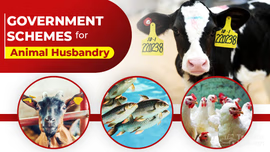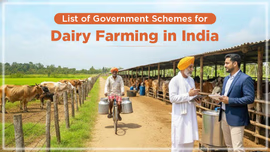Government Schemes to Promote Fish Farming in India 2025

India has a vast coastline and several inland water bodies, making it ideal for fish farming. The fisheries sector of India significantly contributes to the country's economic growth and food security. The fishing industry in India is experiencing growth, and the government's involvement and assistance through various schemes are key drivers of this growth. This blog explores the various government schemes aimed at promoting fish farming in India.
Table of Contents
- Overview of the Fisheries Sector
- What are the Government Schemes to Promote Fish Farming in India?
- State Government Schemes to Promote Fish Farming in India
Overview of the Fisheries Sector
Currently, India ranks second in the world in terms of fish production, accounting for approximately 8% of global fish production. The Indian fisheries sector has undergone significant transformation and growth between 2004 and 2024, driven by policy reforms and technological advancements. In the 2014-24 period, the fish production increased by 88.23 lakh tons to reach 184.02 lakh tons. The Inland and Aquaculture fish production increased by 77.71 lakh tons, while marine fish production reached 10.52 lakh tons for the period 2014-24. During 2023-24, the seafood export was noted to be 17,81,602 MT, which was worth Rs. 60,523.89 crores.
In addition, the Union Budget 2025-26 set aside a major portion of the annual budget for the fisheries sector, with support of Rs. 2,703.67 crores. Also known as the Sunrise Sector, the Indian fisheries sector supports the livelihoods of more than 30 million individuals across the country. Overall, it contributes significantly to the food and nutritional security, employment generation, national income and exports of India.
What are the Government Schemes to Promote Fish Farming in India?
The government of India has introduced several schemes to promote fish farming and overcome its associated challenges.
Fisheries and Aquaculture Infrastructure Development Fund (FIDF)
- Established by the Department of Fisheries, Ministry of Fisheries, Animal Husbandry, and Dairying, Government of India in 2018-19, this fund addresses the requirements of the marine and inland fisheries sector regarding modernisation and infrastructure development.
- A wide range of activities is targeted under this fund, including establishing fishing harbours & fishing landing centres, modern fish market development, hatchery & aquaculture development, setting up brood banks & fish transport facilities, construction of cold storages, etc.
- The loan eligibility under this fund is up to 80% of the project's actual cost. This fund also offers up to 3 per cent annually for developing the infrastructure related to fisheries. The beneficiaries are expected to contribute a minimum of 20% of the total project cost.
- The FIDF scheme applies in all UTs and states and has no limits for the area or number of units. It has a maximum 12-year repayment period, including a 2-year moratorium on principal repayment.
- The initial size of the fund was Rs. 7522.48 crores for the period 2018-19 to 2022-23. However, the government has extended the scheme by 3 more years, until 2025-26, with an additional budget support of around Rs. 940 crores.
Pradhan Mantri Matsya Sampada Yojana (PMMSY)
- Set up by the Ministry of Fisheries, Animal Husbandry and Dairying in 2020-21, this transformative scheme aims to boost the fisheries sector. It was launched for a period from 2020-21 to 2024-25. However, the ministry has extended this scheme up to FY 2025-26.
- Also, Pradhan Mantri Matsya Kisan Samridhi Sah-Yojana (PM-MKSSY) is a Central Sector Sub-scheme launched under PMMSY for the period of FY 2023-24 to FY 2026-27. It involves an investment of more than Rs. 6,000 crores to formalize the fisheries sector, while supporting fisheries micro and small enterprises
- PMMSY is an umbrella scheme with two components: the Centrally Sponsored Scheme and the Central Sector Scheme. The former includes beneficiary-oriented and non-beneficiary-oriented activities, whereas the latter consists of support to government entities.
- It aims to develop India's fisheries sector in a sustainable and responsible manner. The additional objective involves enhancing fish production, offering social and economic security to fish farmers and fishers, doubling their income, and modernising the value chain.
- Different beneficiaries of this scheme include individuals with a background in the fishing sector, private firms and entrepreneurs, and states and UTs.
- The central government bears the total cost under the Central Sector Scheme. In non-beneficiary-oriented activities, the project cost is divided between the central and state governments, and this division is also similar in beneficiary-oriented activities.
- On the 4th anniversary of PMMSY, the government announced various initiatives, including the NFDP Portal and PM-MKSSY guidelines, Climate Resilient Coastal Fishermen Villages, Fisheries Cluster Development, a Drone Technology Pilot, and Research and Breeding Centers.
Kisan Credit Card (KCC)
- In 2018-19, the Indian government extended the Kisan Credit Card (KCC) scheme to fish farmers to fulfil their demands related to working capital.
- Through this scheme, KCC loans of up to Rs 2 lakhs are available for fishers and fish farmers at a 7% subsidized interest rate. In 2025-26, the lending limit of loans under KCC was increased up to Rs. 5 lakhs.
- A key benefit is that if a farmer repays loans promptly on time, they will get a Prompt Repayment Incentive (PRI) of 3%, which reduces the interest rate to 4%.
- A total of 4,63,492 KCC cards with a loan amount of Rs. 2982.58 crores have been issued to fishers and fish farmers across all states and union territories.
State Government Schemes to Promote Fish Farming in India
Schemes for the fishing industry are also promoted independently by certain states, such as Odisha and West Bengal.
Mukhyamantri Maschyajibi Kalyan Yojana (MMKY)
Launched in 2024, this is a new scheme to support women’s self-help groups, as well as fishermen and fish farmers in Odisha. Odisha is primarily a maritime state, with 7 coastal districts and a coastline of 480 km. More than 5 lakh marine fishers rely on fishing for earning their livelihood. MMKY functions to not only generate more jobs in the fisheries sector but also to increase fish production. This scheme was launched with a budget of Rs. 448 crores for 16 welfare programmes. With the support of MMKY, fishermen and fish farmers receive suitable support and resources to grow their businesses.
Matsya Jeebi Credit Card (MJCC)
MJCC was launched in 2021 as a credit delivery mechanism to provide institutional Short-Term Credit support to fish farmers. It helps them to meet their working capital requirements. Thus, it reduces reliance on the informal banking sector for credit. The credit limit may vary but is usually up to Rs. 3 lakhs. Additionally, the scheme provides a flexible repayment schedule tailored to the harvesting season, offering support to fish farmers. There is also no need for collateral for loans up to Rs. 1.6 lakhs. There is also provision for interest subvention in the event of timely loan repayment. All fish farmers are eligible for MJCC, including fishers working in dry fish processing and other allied fish businesses.
The Indian government is committed to promoting the country's fisheries sector to ensure food security, improve the socio-economic condition of fish farmers, and increase export potential. Through schemes like FIDF and PMMSY, it is focusing on various aspects of the fishing industry, including effective aquaculture activities, improving infrastructure in the value chain, and disseminating knowledge about new technologies. With proper research, knowledge, and capital, one can quickly establish a profitable fish farming business in India. A continuous push for improvement will enhance the fisheries sector and improve the livelihood of the farmers involved.


Related Blogs












